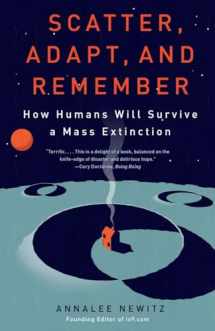
Scatter, Adapt, and Remember: How Humans Will Survive a Mass Extinction
ISBN-13:
9780307949424
ISBN-10:
0307949427
Edition:
Illustrated
Author:
Annalee Newitz
Publication date:
2014
Publisher:
Knopf Doubleday Publishing Group
Format:
Paperback
320 pages
Category:
Environmental Economics
,
Economics
,
Astrophysics
,
Physics
,
Evolution
,
History & Philosophy
,
Disaster Relief
,
Social Sciences
,
Popular Culture
FREE US shipping
Book details
ISBN-13:
9780307949424
ISBN-10:
0307949427
Edition:
Illustrated
Author:
Annalee Newitz
Publication date:
2014
Publisher:
Knopf Doubleday Publishing Group
Format:
Paperback
320 pages
Category:
Environmental Economics
,
Economics
,
Astrophysics
,
Physics
,
Evolution
,
History & Philosophy
,
Disaster Relief
,
Social Sciences
,
Popular Culture
Summary
Scatter, Adapt, and Remember: How Humans Will Survive a Mass Extinction (ISBN-13: 9780307949424 and ISBN-10: 0307949427), written by authors
Annalee Newitz, was published by Knopf Doubleday Publishing Group in 2014.
With an overall rating of 4.1 stars, it's a notable title among other
Environmental Economics
(Economics, Astrophysics, Physics, Evolution, History & Philosophy, Disaster Relief, Social Sciences, Popular Culture) books. You can easily purchase or rent Scatter, Adapt, and Remember: How Humans Will Survive a Mass Extinction (Paperback, Used) from BooksRun,
along with many other new and used
Environmental Economics
books
and textbooks.
And, if you're looking to sell your copy, our current buyback offer is $0.6.
Description
A Los Angeles Times Book Prize Finalist in Science & Technology
In its 4.5 billion-year history, life on Earth has been almost erased at least half a dozen times: shattered by asteroid impacts, entombed in ice, smothered by methane, and torn apart by unfathomably powerful megavolcanoes. And we know that another global disaster is eventually headed our way. Can we survive it? How? In this brilliantly speculative work of popular science, Annalee Newitz, editor of io9.com, explains that although global disaster is all but inevitable, our chances of long-term species survival are better than ever. Scatter, Adapt, and Remember explores how scientific breakthroughs today will help us avoid disasters tomorrow, from simulating tsunamis or studying central Turkey’s ancient underground cities, to cultivating cyanobacteria for “living cities” or designing space elevators to make space colonies cost-effective. Readers of this book will be equipped scientifically, intellectually, and emotionally to face whatever our future holds.
In its 4.5 billion-year history, life on Earth has been almost erased at least half a dozen times: shattered by asteroid impacts, entombed in ice, smothered by methane, and torn apart by unfathomably powerful megavolcanoes. And we know that another global disaster is eventually headed our way. Can we survive it? How? In this brilliantly speculative work of popular science, Annalee Newitz, editor of io9.com, explains that although global disaster is all but inevitable, our chances of long-term species survival are better than ever. Scatter, Adapt, and Remember explores how scientific breakthroughs today will help us avoid disasters tomorrow, from simulating tsunamis or studying central Turkey’s ancient underground cities, to cultivating cyanobacteria for “living cities” or designing space elevators to make space colonies cost-effective. Readers of this book will be equipped scientifically, intellectually, and emotionally to face whatever our future holds.


We would LOVE it if you could help us and other readers by reviewing the book
Book review

Congratulations! We have received your book review.
{user}
{createdAt}
by {truncated_author}




